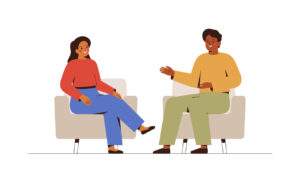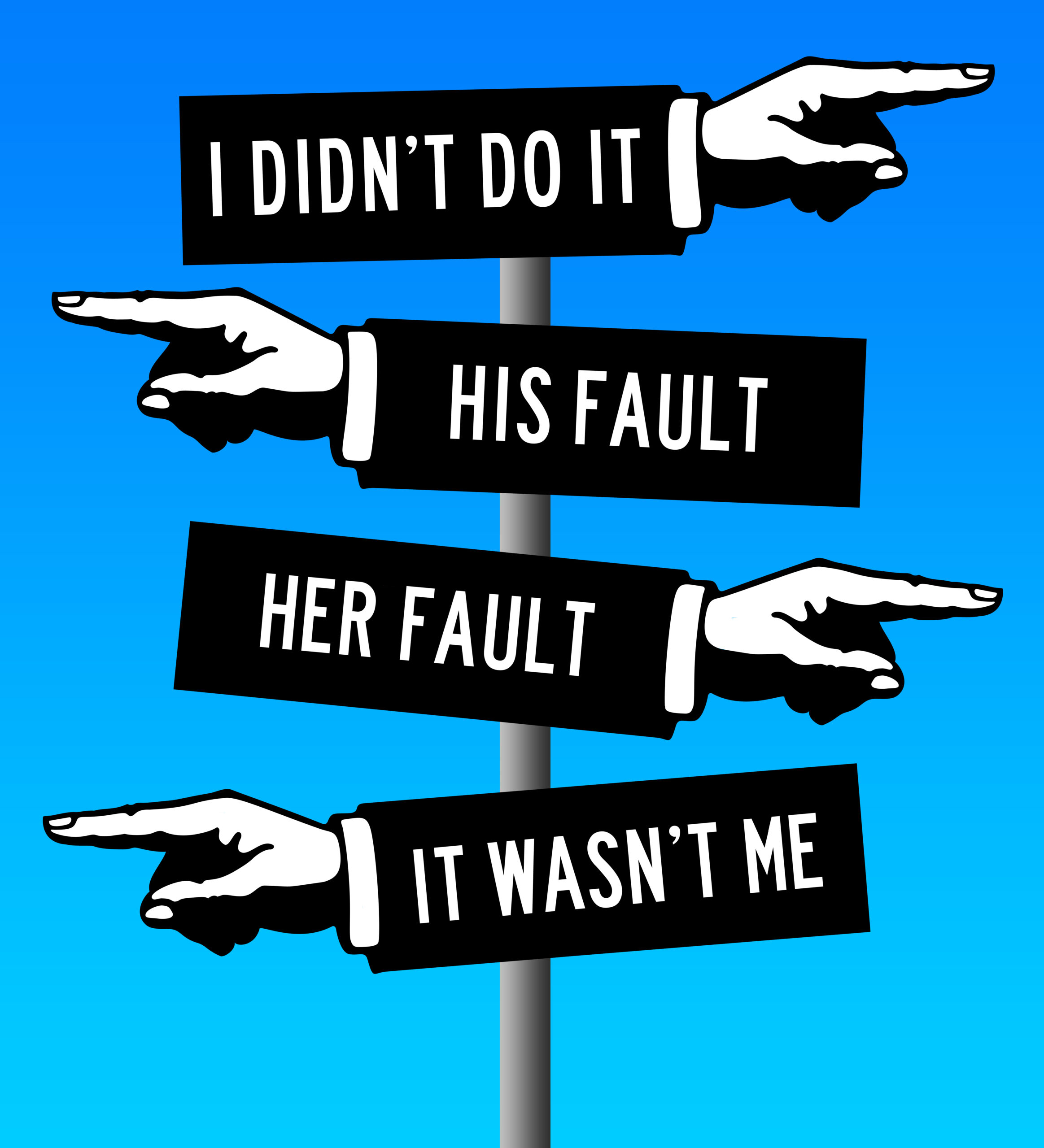
Learning a few speaking and listening tools can mean the difference in having a successful relationship.
To be heard, learn effective talking and listening skills.
by Becky Whetstone, Ph.D.
Sandra said that she took her husband’s lack of interest in her painting and artwork personally.
“I just don’t get why he can’t care about what I care about,” she said. “I try to visit with him about it and his eyes go blank. He says nothing. It hurts me that he cares nothing about something that I care so much about.”
“I do care,” said Jack, “I’m just not dancing a jig every time you bring it up. I’m understated in my reactions anyway, you know that.”
Conversations like Sandra and Jack’s are typical of what I see in marriage therapy. One person literally makes up what their partner is thinking and feeling and gets themselves in a snit about it, while the other partner seems perplexed and misunderstood. Once I teach them healthy communication skills, including appropriate boundaries for speakers and listeners, this kind of interaction will likely end.
Everyone needs to learn talking and listening boundaries.* In my opinion, it should be taught in 7th grade throughout the USA, if it was, it would change everything. The reason for learning appropriate boundaries is to be able to show up as your authentic self and to show the true you to those you care about and love, as opposed to showing up as who you think others want to see, or who you think you should be. Showing your true self means being real and vulnerable, saying what you mean, and meaning what you say. In long term relationships where two people are open and accepting of one another and using good communication as I am about to describe, it is highly correlated to better relationships, emotional well-being, joy, and deep bonding. In my therapy practice of many years, I’ve never met anyone that didn’t need to learn this. In case you’re still not sure learning talking and listening boundaries is for you, use the list below to make certain. You need to learn talking and listening boundaries if you or your partner …
- Take things personally.
- Blame and finger-point.
- Jump to conclusions.
- Put words in the speaker’s mouth.
- Don’t listen or accuse one another of not listening.
- Accuse you of saying or believing things that aren’t true.
- Tells you what you think or feel.
- Says the words, “You made me …” or “You always…” or “You never…” or “You don’t …”
- Try to control or manipulate.
The first step for both types of boundaries is to find an appropriate physical distance for the conversation you are about to have. Each person must figure out what is comfortable for them. You do that by tuning into yourself, your body, and standing or sitting where you are most comfortable and at ease. Once your appropriate personal space is attained …
Listening and talking boundaries. Perception is a tricky thing. People tend to take what another says, run the information through a brain filter based on their own experiences, and create a meaning. Often, the meanings they make are wrong. Ever felt misunderstood? It’s probably because you were talking to someone who doesn’t practice healthy speaking boundaries. It is vitally important to learn how to check if what you are telling yourself about someone else is true. That means you have solid and direct evidence that it is. It will soon be part of your speaking boundary to only say things to the listener you know are true. You can always offer up conjecture, but if you do, you must tell the listener that what you’re thinking is just a guess.
Why? Because as soon as you tell your partner something about themselves that they don’t agree with, the next thing they’ll do is shut off and stop listening altogether. This is what couple after couple in my practice do. Someone makes an extreme accusation, like “You always,” or “You never.”
Jack shut down, or blew her off, when Sandra accused him of not caring about her art, which he knows is not true. To him, what she was saying was so ridiculous as to not merit a response. She lost her chance at meaningful communication about it because she started off the conversation with an extreme accusation that she made up from her own insecurities but had no evidence to back it up with. Many times, people do this to be manipulative. For example, it’s possible Sandra is trying to manipulate Jack into revealing his true feelings about her art, or to tease out praise through guilting him. For Jack and Sandra, and everyone reading this, the good news is that accurate and clear communication can be learned, and learning it is an important step to having the connection, love, and emotional intimacy all of us long for.
“Sandra,” before you accused Jack of not caring about your art, did you have proof that he didn’t?” I asked.
“No, she said. “It’s just that he doesn’t show me that he is, so I assumed …”
Sandra violated a talking boundary by making up what she believed to be true about Jack, instead of just asking him. She could have said, “Jack sometimes I wonder if you care about my love of painting and art, because you don’t seem to show it. Do you care?”
This would have allowed him the opportunity to correct her perception.
‘Of course, I care about your art, honey,” he might have said. “I guess I should express it more often. I didn’t know it was so important to you that I speak out about it, but yes, I care very much.”
Good communication requires being factual and accurate. If you’re not sure about what someone thinks or feels, never assume, ask them. Jack may be passionately in love with, and interested in all things Sandra, but he is introverted and quiet in self-expression. My own husband is this way, but if I create a safe space for him to be go deeper in his expressions, I can pull what he really thinks or feels out him. His personality is such that he is not likely to express the things he likes about Becky spontaneously. I can live with that so long as he’s willing to speak about it, and he is.
“My husband says I am lazy, says Shirley. “And I am not lazy. How do I protect myself from that?”
By understanding that it isn’t true. If someone tells you something that isn’t true about yourself, catch it in an imaginary baseball mitt, look at it, conclude it isn’t true, and throw it down on the ground energetically. That’s using your listening boundary. Practicing boundaries as a listener means detaching yourself from feeling emotions about what is said that isn’t true. A person who jumps out of their chair in outrage with a finger pointed at the speaker who just said something false about them is not practicing listening boundaries.
If the information the speaker says is true, and it hurts you, allow yourself to feel emotions about the truth. If what you hear is questionable, you probably don’t have enough details, so ask for more information. All too often when we are confused about what a person is saying about us, we assume the worst rather than give them the benefit of the doubt. I believe that most people, especially our romantic partners, are not trying to stick a knife in our hearts whenever they make an observation. It’s a good rule of thumb to err on the side that most people mean no harm when they make observations about us.
A listener must keep a few things in mind when practicing respectful communication. Number one is, remind yourself to not take the blame or become defensive as you listen. Defensiveness is not an option as a response. You will stand there, listen to what the person is saying, mindful of your breathing and working to stay calm, while telling yourself, “The speaker is just showing me who they are right now.” The purpose of listening is to find out who the speaker is. That’s it. Have this tattooed on your wrist if you must, but in every interaction with another, what the person says or does shows you a little piece of who they are, and how they think. It’s not about you or for you. It’s about what they are perceiving.
For example, if Shirley’s husband thinks she is lazy, there is something in his belief system driving that. He may have been in a bad mood overall, and/or raised to believe that anyone who takes a break, rests, sits down for longer than five minutes, or takes a nap is lazy. He may have been shamed by his family for wanting to slack as a child. Unfortunately, a lot of families are like that. When he called Shirley lazy, he is simply telling her what his belief system is. That’s about him, and not about her. Shirley is responsible for herself. In therapy, I would ask her husband, Jorge, about his belief system around laziness, and we’d find out where his thought is coming from right away. Usually, when we do this, it easy to see how his belief system probably needs revisiting, and maybe even an update. Even if resting is equal to being lazy, which it isn’t, it is not his place to make unsolicited observations to any adult without asking if he may do so. Adults have the right to be who they are, but sometimes some of their learned behaviors are not healthy in personal relationships. With some conversation, especially receiving professional help with a therapist, Jorge may come to see that resting is self-care, and necessary, and he may come to feel happy for Shirley when she slips away from yard work to sit for a while.
If Jorge doesn’t change his beliefs about resting, Shirley can at least acknowledge he has the right to be different. Her emotions should be tied to what she believes is true about herself, and not what anyone else thinks. No one else has the right to tell you who you are, how you think or feel, or what you ought to be doing. If you need to nap, go nap, and make it a good one. You’re an adult and have free will to take care of yourself as needed. Practicing appropriate boundaries means accepting someone as they are. Marriages won’t do well if one or both people are offering up unsolicited advice and observations, and that’s not acceptable behavior in relationships, anyway, as doing it leads to feelings of resentment. What is acceptable is to ask another if you may share what you are thinking. If they say no thanks, stop right there, then go take care of yourself. We must respect the listener if the listener doesn’t want to hear what we would like to share.
Here’s another good example of how a person failed to use listening boundaries: A spouse walks in the door after work and says, “The house sure is messy.” The speaker did not accuse or blame anyone for the messy house. They made a statement. However, on this day, the listener assumed the worst, that the speaker meant to criticize them. They jump to a conclusion that they are being blamed, their nervous system gets activated, and they aggressively respond with, “Who do you think you are? I’ve been slaving around here all day with three small kids, and you have the nerve to talk about how messy the house is? You expect too much from me!”
What would have changed the outcome is if the listener had said, “What do you mean by that? It wasn’t super clear.”
“I meant that the house is messy,” that’s it. “I understand why it’s messy, and I’m about to tidy it up a bit. Is there anything else you’d like me to help with?” Explosion averted.
Talking boundaries. The purpose and clear goal of talking to someone is to be known. You may let it be known you are too hot inside the house, for example. You may want to express frustration with the current state of politics in the United States, or let it be known you’d enjoy some affection soon. This is a great way to connect with people, by letting them know who you are, what you want, and what you need. When practicing talking boundaries, what you do not want to do is use the conversation to control, manipulate, or blame. To do any of those would be a blatant boundary violation. Another important aspect of talking boundaries is to control the tone, emotions, and energy you project when you speak. A healthy communication style does not involve harshness, dominance, contempt, or nonverbal cues such as angry facial expressions or frustrated sighs. Instead, we moderate our emotions prior to communicating, using breathing techniques if necessary. A great breathing technique is to count your breaths per minute. The average healthy breath is 10 to 12 breaths per minute. Work to get yourself there and go even lower if you can. Breathing is key to controlling your emotions and energy, try it.
When it’s your time to speak, state what happened, or what you’d like to share. Never use words that are demeaning. Here’s an example: “Darling, I can’t hear the television at such a low volume. Would you mind turning it up for me?” This is better than, “Stop being a selfish jerk and turn that damn TV volume up. Why do I have to remind you every single time? It’s like you think you’re the only person in the room!” If you want to make an observation about someone, it helps if you say something like, “I just made up that you don’t really want to go to my mother’s house this weekend, but thought I’d better ask you instead.” Another is, “I noticed you have been napping a lot lately, I made up that you are going to bed and waking up too early, before you are tired, and that’s why you need to nap during the day.” If you want to talk about your feelings, you might say, “And about your napping I made myself feel angry, because I made up you weren’t taking good care of yourself and maybe even avoiding me.”
To delineate that you don’t know the exact reason for X, it is a good idea to use terms like, “I made myself feel …” or “I made up why you …” These are examples of boundaries that work. Whatever you do, do not tell another adult what they are thinking, feeling, or doing. It’s a terrible boundary violation and it’ll go south every time.
One of the most aggravating types of behavior human beings engage in is when they don’t know or understand why someone said or did something, they make up the why. In other words, they guess. Made up and unconfirmed information about another is meaningless. Years ago, a journalist from the National Enquirer called and asked me to comment as a therapist about why Brittany Spears shaved her hair off. Practicing speaking boundaries, I said, “I have no idea, and no one else knows either unless she has told them herself.” I was appalled the next time I was in the grocery store and saw the front-page article in the check-out line. The reporter apparently called around until they were able to find a therapist willing to guess why she shaved her head. What the therapist said was meaningless garbage. And of course, my comment wasn’t used at all. In political dialogue this sort of thing happens all the time. “Why did the President do that?” All anyone can do is guess until the President tells us themself.
As I said before, it is an important step in talking boundaries to acknowledge to your listener that you don’t have all the needed information to understand what is going on, and what you are guessing is true about them is all made up. “I made up that you come home late from work every evening to avoid being with the family. Am I right?” If you don’t clarify your suspicions, you might fall into the trap of making yourself miserable over something you told yourself that wasn’t even true. I once had a client who imagined that her husband was about to file for divorce, so, like a child, she ran and filed for divorce first. Well guess what? Divorce never even crossed his mind, and his wife created a huge legal and family mess by stuff she made up in her head. Don’t become a victim of your own imagination. Clarify. Ask questions. The most important thing you can do is get whatever information you want or need from the horse’s mouth. If the two could have had an honest conversation as adults, a lot of needless drama could have been avoided.
Healthy communication is one of life’s best social skills. Take the time to learn these effective communication skills. In talking boundaries restraint is key. We can’t flop any old unfiltered phrase out of our mouths and expect to have great relationships. For example, when I was in junior high, a young man who broke up with me said, “I suppose you’re too much of a wicked witch to give me my friendship ring back.” Yup. He’d have gotten the dime store ring that was making finger green back had he been respectful in how he asked. In talking and listening boundaries, you must control, restrain, and edit yourself and take the feelings of others into consideration. When listening, make a mental note that the speaker is showing you who they are.
*Note: Talking and listening boundaries come from the work of Pia Mellody, author of Facing Codependence, Intimacy Factor, Breaking Free workbook, and Facing Love Addiction. She created a model for how to recover from childhood developmental trauma, that renders us all emotionally immature. The model helps us grow ourselves up and able to have healthy relationships. I highly recommend that every person come to know the life-changing work of Pia Mellody, and if you need therapy, seek a Pia Mellody or PIT (Post Induction Therapy) trained therapist. You can find one through the Healing Trauma Network. I will continue to write about her powerful concepts, making them user friendly, so you may have the relationships you desire. Please tell me what you think!
Becky Whetstone, Ph.D. is a licensed Marriage & Family Therapist in Arkansas and Texas*, and is known as America’s Marriage Crisis Manager® . She has worked with thousands of couples to save their marriages. She is also co-host of the Call Your Mother relationship show on You Tube, and has a private practice in Little Rock, Arkansas, and as a life coach via teletherapy. To contact her check out www.DoctorBecky.com and www.MarriageCrisisManager.com. Don’t forget to follow her on Medium so you don’t miss a thing!
*For licensure verification find Becky Whetstone Cheairs.
Additional reading
If You Want to Keep your Relationship, Stop Doing These Three Things Now.





 Becky Whetstone is an Arkansas native and has a Ph.D. in Marriage and Family Therapy from St. Mary’s University in San Antonio, Texas. She is a Licensed Marriage and Family Therapist (LMFT) in Texas and Arkansas.
Becky Whetstone is an Arkansas native and has a Ph.D. in Marriage and Family Therapy from St. Mary’s University in San Antonio, Texas. She is a Licensed Marriage and Family Therapist (LMFT) in Texas and Arkansas. 





















































































































